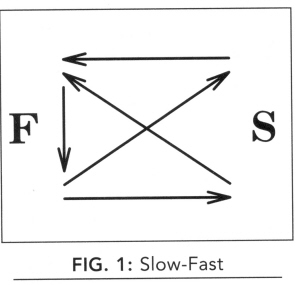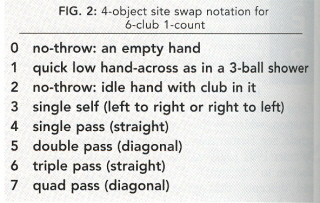|
Juggler's Workshop
Passing
Lots 0' Clubs BY
MARTIN FROST
In
this issue I'm going to describe a couple of passing patterns for you
to warm up
with and then some more complex ideas that you can sink your teeth
into (but hopefully not the other way around). Fast-Fast The
Fast-Fast is my extension on the Slow-Fast pattern (described in the Summer
1992 Juggler's Workshop). In the
The
Fast-Fast version is the same except that the slow juggler adds one
self before each pass. The fast juggler doesn't change but continues
to feed the slow juggler's two hands. The "slow" juggler now
has to hurry (making this the FastFast pattern) in order to do:
right-self,
left-pass, left-self, right-pass. The self is always done from the
hand that a pass is coming to.
This
can be extended further by having the so-called slow juggler add a
second self
before each pass to do a very fast 3count. The fast juggler continues
to feed the slow juggler's two hands but in fact will undoubtedly have
to slow down to give the slow juggler enough time. The slow juggler has
become the faster juggler.
If the fast juggler now adds a second self before each pass, the pair can easily switch into a normal 3-count. Also, notice that in the basic Fast-Fast above, with the slow juggler doing one self before each pass, the slow juggler is doing a version of RightRight-Left-Left (described in the same Summer 1992 article). So you can see how all these seemingly disparate patterns are really closely related.
1-Count
Site Swaps Few
people who have learned the 6club 1-count realize that doubles and
triples and combinations thereof can be added to this "ultimates"
pattern. We've been doing such throws for many years but a recent
discovery by Simon Bostrom and Brendan Brolly in England has made it
easy to construct a certain class of site swaps for the 1-count.
My
old basic rule was: If you throw a diagonal double, you've put four
clubs on one side of the pattern, so you have to move one back to the
other side pretty soon. This is easily done with either a self or
another double from the other hand. Thus you can throw, starting
from either hand: double, self; or double, double, pause; or double,
double, double, hand-across; or double, double, double, double, pause.
These
are late doubles, so the receiver has a pause before the first double
comes in. The trick for the receiver is: Don't throw a club back from
a hand that doesn't get a pass.
The
discovery is that you can look at a
Next
we just apply 4-object site swap theory to come up with some 6-club
1count site swaps. (Those of you not familiar with site swap notation
might want to read the Summer 1991
Juggler's World article by Bruce (Boppo) Tiemann and Bengt
Magnusson: "A Notation for Juggling Tricks. A LOT of
Juggling Tricks.")
Fig.
2 shows the 4-object site swap notation we'll use for the 6-club
1-count. Each number represents one hand's action on a given count. A
sequence of such numbers represents alternate right and left hands of
one person. For instance, 45623 means a R single pass, a L double
diagonal pass, a R triple pass, a L pause, and a R self. A sequence can
be repeated over and over or it can be done just once before going back
into the basic pattern (the 1-count here) or some other sequence.
The
normal 1-count is notated just 4, since all throws are 4's. The patterns
I mentioned above, with doubles and either matching doubles or selves to
get three clubs back
on each side, are notated: 53, 552, 5551,55550 (do you notice a
pattern?). |

